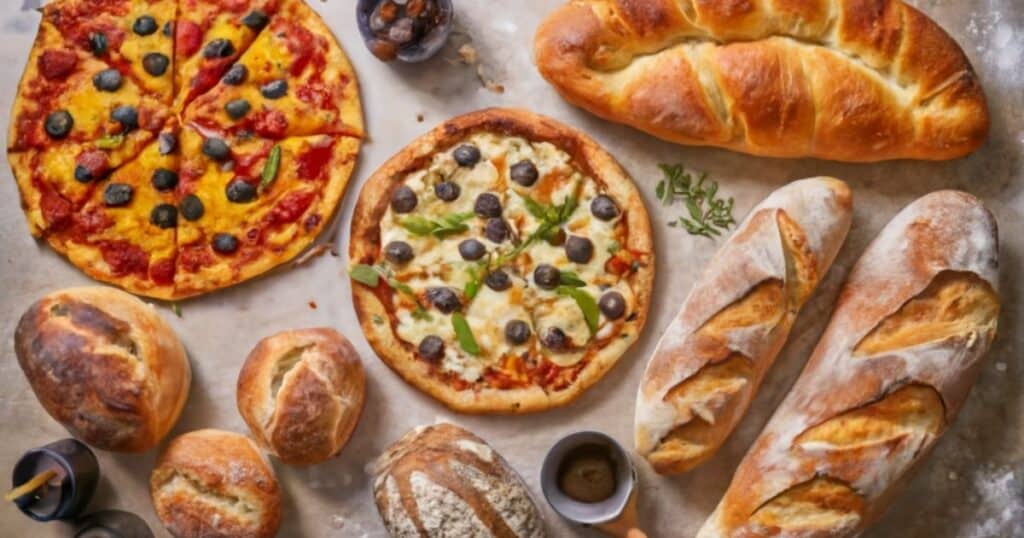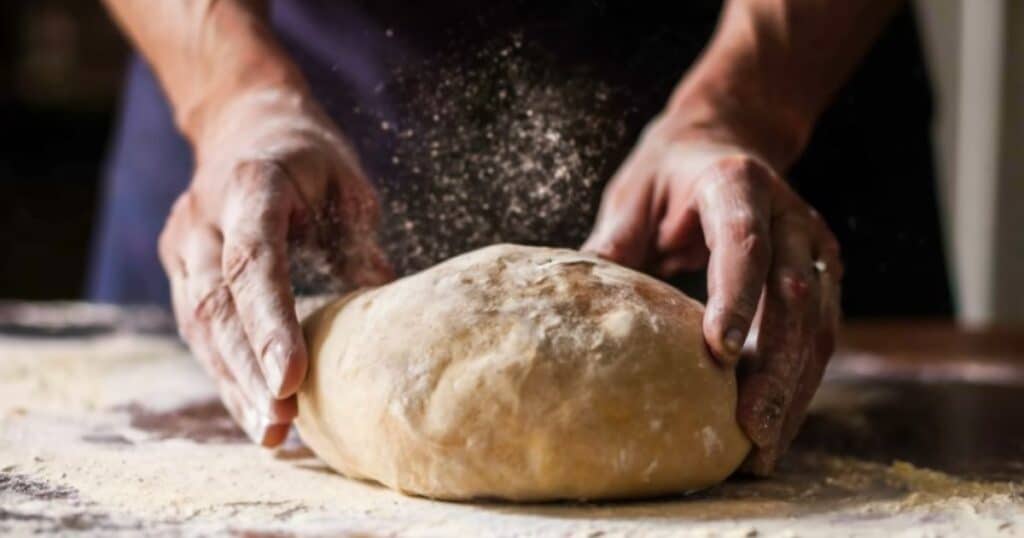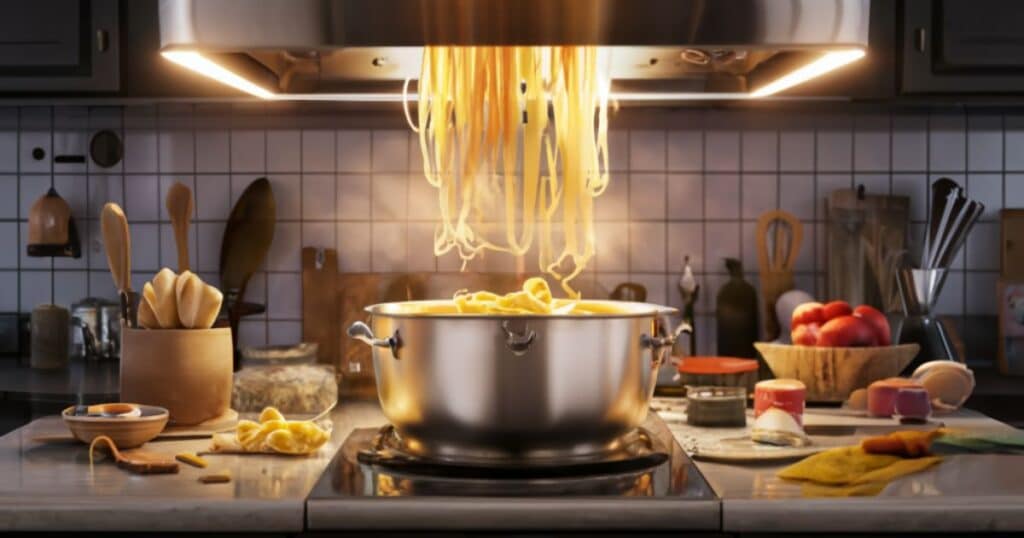In the kitchen, things can be kneaded. This means pressing and folding the dough to make it smooth. Bread and pizza dough are examples of things that might be kneaded in the kitchen.
In the kitchen, kneading happens when you press and fold dough to make it smooth. This skill is often used when making bread or pizza. It’s like giving the dough a good massage to make it soft and stretchy. So, next time you’re in the kitchen, think about giving your dough a little knead!
Kneading is a way to press and fold dough to make it smooth and stretchy. It’s like giving the dough a good massage. People often knead dough when they make bread or pizza. So, what might be kneaded in the kitchen? Dough for delicious treats!
Dough-Based Products
Dough-based products refer to a wide range of food items that are made primarily from dough, a mixture typically consisting of flour, water, and other ingredients like yeast, salt, sugar, or fats. These products are created by shaping, kneading, and baking or frying the dough.

Examples include bread, pizza, pastries, cookies, pretzels, and pasta. Each type of dough-based product has its own unique recipe, preparation method, and characteristics, but they all share the fundamental aspect of starting with dough as the main ingredient. These products are often beloved comfort foods enjoyed by people all over the world.
Bread
Bread is a staple food made from dough, typically consisting of flour, water, yeast, salt, and sometimes sugar or fat. The dough is kneaded to develop gluten, which gives bread its structure and elasticity. After kneading, the dough is left to rise, allowing the yeast to ferment and create carbon dioxide gas, which causes the dough to expand.
The risen dough is then shaped into loaves or other forms and baked in an oven. Bread comes in various types, including white, whole wheat, rye, and sourdough, each with its distinct flavor and texture. It is a versatile food that can be enjoyed on its own, as a sandwich, or as an accompaniment to meals.
Different types of bread dough (yeast-based, sourdough, quick pieces of bread)
Yeast-based dough: Utilizes yeast as a leavening agent, which ferments the dough to create carbon dioxide gas, resulting in a light and airy texture. Commonly used in traditional bread recipes.
Sourdough: Made using a fermented dough starter containing wild yeast and bacteria, which give the bread a tangy flavor. It undergoes a slower fermentation process, resulting in a unique taste and texture.
Quick bread: Do not require yeast and instead use baking powder or baking soda as leavening agents. They rise quickly during baking, making them ideal for fast preparation, and include varieties like banana bread, cornbread, and soda bread.
Techniques for kneading bread dough
Kneading bread dough means pressing and folding it to make it smooth. It’s like giving the dough a good massage. This helps develop gluten, making the bread soft and stretchy. So, kneading is an important step in making delicious bread!
Importance of kneading for gluten development
Kneading is crucial for developing the gluten in the dough. Gluten is a protein that gives bread its structure and elasticity. When the dough is kneaded, gluten strands form and align, creating a network that traps carbon dioxide produced by yeast during fermentation.
This network allows the dough to rise properly and results in a light and airy texture in the finished bread. Therefore, proper kneading is essential for achieving the desired texture and quality in bread.
Recommended Post: Who Is Bigfoot In Kitchen Confidential?
Pizza Dough
Pizza dough is the base for making delicious pizza. It’s made from simple ingredients like flour, water, yeast, salt, and sometimes olive oil or sugar. First, the ingredients are mixed to form a dough. Then, the dough is kneaded until it becomes smooth and elastic, which helps develop gluten for a chewy texture. After that, the dough is left to rise, allowing it to become lighter and puffier.
Finally, it’s rolled out and topped with sauce, cheese, and other toppings before being baked to perfection. Making pizza dough at home is easy and fun, and it’s the foundation for creating your custom pizzas with your favorite flavors!
Characteristics of pizza dough
Pizza dough has several distinctive characteristics:
- Elasticity: Pizza dough is stretchy and elastic, allowing it to be easily shaped and stretched into a thin crust without tearing.
- Chewiness: A well-made pizza dough has a satisfying chewiness, thanks to the development of gluten during kneading.
- Airiness: Properly risen pizza dough becomes light and airy after baking, resulting in a crisp yet tender crust.
- Flavor: Depending on the recipe and fermentation process, pizza dough can have a subtle yeasty flavor or a more pronounced sourdough tang.
Kneading methods for pizza dough
There are different methods for kneading pizza dough:

Hand kneading: This traditional method involves using your hands to press, fold, and stretch the dough until it becomes smooth and elastic.
Stand mixer: Using a stand mixer with a dough hook attachment can make kneading easier and less labor-intensive. The mixer kneads the dough while you control the speed.
Food processor: Some recipes allow for kneading pizza dough in a food processor fitted with a dough blade. This method is quick and efficient but requires careful monitoring to prevent over-kneading.
No-knead method: Alternatively, some recipes utilize a no-knead approach, where the dough is simply mixed and left to ferment for an extended period, allowing the gluten to develop naturally without the need for kneading.
Impact of kneading on crust texture
Kneading significantly impacts the texture of the crust in pizza dough:
Chewiness: Proper kneading helps develop gluten, resulting in a chewy texture in the crust. The more the dough is kneaded, the more gluten strands are formed, leading to a chewier crust.
Airiness: Kneading also affects the distribution of air bubbles in the dough. The well-kneaded dough tends to have a more uniform distribution of air bubbles, resulting in a lighter and airier crust after baking.
Crispiness: Additionally, the level of kneading can influence the crispiness of the crust. Over-kneading can lead to a tougher and denser crust, while under-kneading may result in a softer and more tender crust.
Overall, proper kneading is essential for achieving the desired texture in the crust, balancing chewiness, airiness, and crispiness for a perfect pizza experience.
Pastry and Desserts
Pastry and Desserts encompasses a wide array of sweet treats, ranging from delicate pastries to decadent desserts. Pastries are baked goods made from dough, typically containing flour, fat, and water, and often filled or topped with sweet or savory ingredients. Examples include croissants, pies, tarts, and eclairs. Desserts, on the other hand, refer to sweet dishes served at the end of a meal or as a special treat.
They can be baked, such as cakes, cookies, and puddings, or non-baked, such as ice cream, fruit salads, and mousses. Both pastries and desserts offer indulgent delights that satisfy cravings and provide moments of culinary enjoyment. They can range from simple, home-baked treats to elaborate creations crafted by professional pastry chefs, making them an integral part of culinary culture worldwide.
Pie Crusts
Pie crusts are the foundation of pies, providing a crisp and flaky base for various fillings. Typically made from flour, fat (such as butter or shortening), water, and salt, pie crusts come in different types, including shortcrust, flaky, and graham cracker crusts. The key to a perfect pie crust lies in achieving the right balance of ingredients and handling the dough with care to prevent it from becoming tough or soggy.
Proper chilling and rolling techniques are crucial for achieving a tender and flavorful crust. Once baked, pie crusts provide a delicious contrast to sweet or savory fillings, enhancing the overall texture and taste of the pie. Whether homemade or store-bought, a well-executed pie crust is essential for creating pies that are both visually appealing and irresistible in flavor.
Role of kneading in pie crusts
The role of kneading in pie crusts is crucial for achieving the desired texture and structure:
Gluten development: Kneading helps to develop gluten in the dough. Gluten gives the pie crust its strength and elasticity, allowing it to stretch without breaking while maintaining its shape during baking.
Flakiness: Proper kneading technique ensures that the fat, usually butter or shortening, is evenly distributed throughout the dough. This results in thin layers of fat between layers of dough, which creates the characteristic flakiness of a well-made pie crust.
Tenderness: While gluten development is important for structure, over-kneading can lead to a tough and dense crust. Therefore, gentle and minimal kneading is often preferred to maintain a tender and delicate texture in the finished pie crust.
Related Content: What Restaurants From Kitchen Nightmares Are Still Open
Techniques for kneading pie dough
There are various techniques for kneading pie dough:
Hand kneading: This traditional method involves gently pressing and folding the dough with your hands on a lightly floured surface. The dough is then shaped into a disc and wrapped in plastic wrap before chilling.
Pastry cutter or fork: Using a pastry cutter or fork, cut the fat into the flour mixture until it resembles coarse crumbs. Then, gradually add cold water and mix until the dough comes together. This method is ideal for those who prefer a flakier crust.
Food processor: Some recipes utilize a food processor to quickly and efficiently combine the ingredients. The cold fat and flour are pulsed together until crumbly, then water is added gradually until the dough forms.
Stand mixer: Similar to the food processor method, a stand mixer with a paddle attachment can be used to mix the dough. However, it’s essential not to overmix to avoid developing too much gluten.
How kneading affects flakiness
Kneading affects flakiness in pie crusts primarily through the distribution of fat and the development of gluten:
Fat distribution: Proper kneading ensures that the fat, such as butter or shortening, is evenly distributed throughout the dough. This results in thin layers of fat between layers of dough. During baking, these fat layers melt and create steam, which lifts the layers of dough and contributes to flakiness.
Gluten development: While gluten development is important for structure, too much gluten can lead to a tough and dense crust. Gentle kneading helps to minimize gluten formation, resulting in a more tender and delicate texture. This balance between gluten development and tenderness is crucial for achieving the desired flakiness in the finished pie crust.
Cookies and Biscuits
Cookies and Biscuits refer to a diverse category of baked treats enjoyed worldwide.
Cookies: Cookies are sweet, bite-sized treats typically made from dough consisting of flour, sugar, butter, eggs, and flavorings such as chocolate chips, nuts, or dried fruits. They are often baked until golden brown and come in a variety of shapes and textures, including soft and chewy, crispy, or crumbly.
Biscuits: In many countries, including the UK and parts of Europe, biscuits refer to what Americans call cookies. However, in the UK and some other English-speaking countries, biscuits can also refer to a type of savory or sweet baked goods similar to what Americans would call crackers or scones. These biscuits can be enjoyed on their own or served with toppings like butter, jam, or cheese.
Incorporating kneading into cookie and biscuit recipes
Incorporating kneading into cookie and biscuit recipes can enhance texture and ensure proper ingredient distribution:
Uniform consistency: Kneading helps to evenly distribute ingredients throughout the dough, ensuring a consistent texture and flavor in every bite of the finished cookies or biscuits.
Gluten development: While cookies and biscuits typically require less gluten development compared to bread, gentle kneading can still help strengthen the dough and improve its structure. This is particularly important for biscuits that rely on a tender yet sturdy texture.
Enhanced texture: Kneading can contribute to the desired texture of cookies and biscuits, whether it’s creating a delicate crumb or ensuring a crisp exterior. It helps to integrate ingredients like chocolate chips, nuts, or dried fruits evenly into the dough, enhancing the overall taste and texture of the final baked goods.
Flavor development: Kneading allows flavors to meld together more effectively, resulting in a more cohesive and flavorful dough. This is especially beneficial for recipes with ingredients like spices or extracts, where thorough mixing can enhance the taste of the cookies or biscuits.
Effects of kneading on texture and consistency
Texture Enhancement
Proper kneading distributes ingredients evenly, leading to a consistent texture.
Kneading facilitates gluten development, resulting in the desired chewiness or tenderness.
Uniformly kneaded dough promotes even baking and a pleasing mouthfeel in the final product.
Consistency Control
Kneading ensures a cohesive dough structure, preventing crumbling or excessive stickiness.
The level of kneading influences the dough’s consistency, impacting its ability to hold shape during baking.
Over-kneading can lead to a tough or dense texture, while under-kneading may result in unevenly baked or fragile baked goods.
Tips for achieving desired results
To achieve the best results:
Follow the recipe instructions carefully.
Use the right technique for kneading.
Be patient and avoid over-kneading.
Pasta Making

A step-by-step guide to making pasta in easy English:
- Prepare the dough: Mix flour and eggs until it forms a dough.
- Knead the dough: Press and fold the dough until it’s smooth and elastic.
- est the dough: Let the dough rest for about 30 minutes to relax the gluten.
- Roll out the dough: Use a rolling pin or pasta machine to flatten the dough into thin sheets.
- Cut the pasta Shape the pasta into desired shapes, such as spaghetti or fettuccine.
- Cook the pasta: Boil the pasta in salted water until it’s al dente, then drain and serve with your favorite sauce.
Fresh Pasta
Fresh pasta is pasta made from scratch using simple ingredients like flour and eggs. Unlike dried pasta, which is store-bought and requires boiling to cook, fresh pasta is made by mixing flour and eggs into a dough, kneading it until smooth, and rolling it out into thin sheets.
These sheets can then be cut into various shapes like spaghetti, fettuccine, or ravioli. Fresh pasta cooks quickly in boiling water, usually within a few minutes, and has a tender texture and delicate flavor. It’s a versatile dish that can be paired with a wide range of sauces, making it a favorite in many kitchens.
Kneading process for fresh pasta dough
The kneading process for fresh pasta dough is straightforward:
Mixing ingredients: Combine flour and eggs in a bowl, and mix until they form a shaggy dough.
Kneading: Transfer the dough to a clean, lightly floured surface. Use the heels of your hands to push the dough away from you, then fold it back over itself. Repeat this motion for about 5-10 minutes until the dough becomes smooth and elastic.
Resting: Wrap the kneaded dough in plastic wrap and let it rest for about 30 minutes at room temperature. This allows the gluten to relax, making the dough easier to roll out.
Rolling: After resting, use a rolling pin or pasta machine to flatten the dough into thin sheets of pasta, depending on the desired thickness for your recipe.
Importance of kneading for elasticity
Kneading is crucial for developing elasticity in dough, including fresh pasta dough. During kneading, the proteins in the flour, specifically gluten, are activated and aligned. Gluten strands form and interconnect, creating a network that gives the dough its stretchiness and elasticity. This elasticity allows the dough to be rolled out thinly and shaped into various pasta forms without tearing or breaking.
Proper kneading ensures that the gluten network is adequately developed, resulting in pasta that maintains its shape during cooking and has a pleasing texture when eaten. Overall, kneading is essential for achieving the desired elasticity in fresh pasta dough, making it easy to work with and ensuring a satisfying final result.
Traditional vs. modern kneading techniques
Traditional Kneading
Involves hand kneading on a clean, floured surface.
Requires physical effort to press, fold, and stretch the dough.
Allows for a tactile connection with the dough, enabling control over its texture and consistency.
Modern Kneading Techniques
Utilize kitchen appliances like stand mixers or food processors.
Offer convenience and consistency in kneading without the need for manual labor.
May require adjustments to kneading times or speeds to achieve desired results compared to traditional methods.
Frequently Asked Questions
What is an example of kneaded?
An example of something that is kneaded is bread or pizza dough, where the process helps develop gluten for a better texture.
What two ways can we knead?
We can knead the dough by hand, using a pressing and folding motion, or with kitchen appliances like stand mixers, which offer convenience and consistent results.
What may need to be kneaded?
Dough for various baked goods such as bread, pizza, or pastry may need to be kneaded to develop gluten and achieve the desired texture.
Conclusion
kneading plays a vital role in the kitchen for creating various delicious treats. Whether it’s bread dough for soft and fluffy loaves, pizza dough for crispy crusts, or pastry dough for flaky pastries, kneading is essential.
It helps develop gluten, giving dough its structure and texture. So, next time you’re in the kitchen, remember the importance of kneading to achieve the perfect consistency in your baked goods.

Warner Clips is an expert writer with 4 years of experience crafting engaging content on Home topics. My expertise ranges from creating cozy environments to tackling Home Improvement projects. Find my work in publications like Huffington Post and Reader’s Digest.







